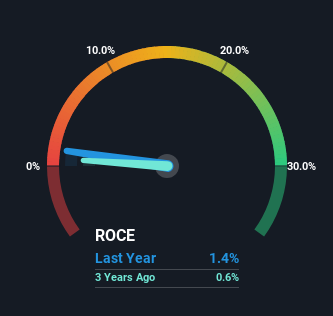Stock Analysis
- China
- /
- Semiconductors
- /
- SZSE:300236
Shanghai Sinyang Semiconductor Materials' (SZSE:300236) Returns On Capital Not Reflecting Well On The Business

To find a multi-bagger stock, what are the underlying trends we should look for in a business? One common approach is to try and find a company with returns on capital employed (ROCE) that are increasing, in conjunction with a growing amount of capital employed. Basically this means that a company has profitable initiatives that it can continue to reinvest in, which is a trait of a compounding machine. However, after investigating Shanghai Sinyang Semiconductor Materials (SZSE:300236), we don't think it's current trends fit the mold of a multi-bagger.
Understanding Return On Capital Employed (ROCE)
Just to clarify if you're unsure, ROCE is a metric for evaluating how much pre-tax income (in percentage terms) a company earns on the capital invested in its business. To calculate this metric for Shanghai Sinyang Semiconductor Materials, this is the formula:
Return on Capital Employed = Earnings Before Interest and Tax (EBIT) ÷ (Total Assets - Current Liabilities)
0.014 = CN¥74m ÷ (CN¥5.8b - CN¥614m) (Based on the trailing twelve months to September 2023).
Thus, Shanghai Sinyang Semiconductor Materials has an ROCE of 1.4%. Ultimately, that's a low return and it under-performs the Semiconductor industry average of 5.8%.
View our latest analysis for Shanghai Sinyang Semiconductor Materials

In the above chart we have measured Shanghai Sinyang Semiconductor Materials' prior ROCE against its prior performance, but the future is arguably more important. If you're interested, you can view the analysts predictions in our free analyst report for Shanghai Sinyang Semiconductor Materials .
What Does the ROCE Trend For Shanghai Sinyang Semiconductor Materials Tell Us?
In terms of Shanghai Sinyang Semiconductor Materials' historical ROCE movements, the trend isn't fantastic. Over the last five years, returns on capital have decreased to 1.4% from 3.9% five years ago. Meanwhile, the business is utilizing more capital but this hasn't moved the needle much in terms of sales in the past 12 months, so this could reflect longer term investments. It's worth keeping an eye on the company's earnings from here on to see if these investments do end up contributing to the bottom line.
The Bottom Line
In summary, Shanghai Sinyang Semiconductor Materials is reinvesting funds back into the business for growth but unfortunately it looks like sales haven't increased much just yet. Since the stock has gained an impressive 54% over the last five years, investors must think there's better things to come. However, unless these underlying trends turn more positive, we wouldn't get our hopes up too high.
On a final note, we've found 1 warning sign for Shanghai Sinyang Semiconductor Materials that we think you should be aware of.
While Shanghai Sinyang Semiconductor Materials may not currently earn the highest returns, we've compiled a list of companies that currently earn more than 25% return on equity. Check out this free list here.
Valuation is complex, but we're helping make it simple.
Find out whether Shanghai Sinyang Semiconductor Materials is potentially over or undervalued by checking out our comprehensive analysis, which includes fair value estimates, risks and warnings, dividends, insider transactions and financial health.
View the Free AnalysisHave feedback on this article? Concerned about the content? Get in touch with us directly. Alternatively, email editorial-team (at) simplywallst.com.
This article by Simply Wall St is general in nature. We provide commentary based on historical data and analyst forecasts only using an unbiased methodology and our articles are not intended to be financial advice. It does not constitute a recommendation to buy or sell any stock, and does not take account of your objectives, or your financial situation. We aim to bring you long-term focused analysis driven by fundamental data. Note that our analysis may not factor in the latest price-sensitive company announcements or qualitative material. Simply Wall St has no position in any stocks mentioned.
About SZSE:300236
Shanghai Sinyang Semiconductor Materials
Shanghai Sinyang Semiconductor Materials Co., Ltd.
High growth potential with excellent balance sheet.

